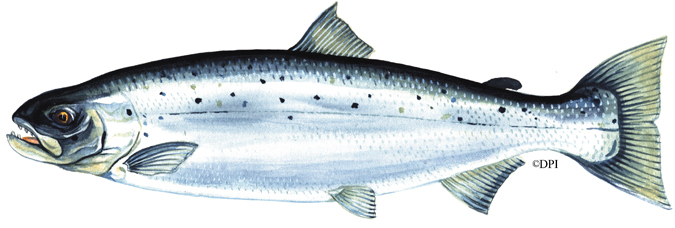Atlantic salmon

| Common Name: | Atlantic salmon |
| Other Name/s: | salmon, grilse |
| Family: | Salmonidae |
| Scientific Name: | Salmo salar (Linnaeus, 1758) |
| Origin: | Introduced |
| The classification of 'introduced' reflects its translocation to Australia and Victoria, and this category is noted in the Flora and Fauna Guarantee Act 1988 (introduced to Australia after 1788 AD). | |
Description
Adult Atlantic salmon are a streamlined and graceful fish, with a slender caudal peduncle (the "wrist" of the tail) which supports a slightly forked tail. They have small black spots scattered on the body (usually 'x' shaped), the tail is usually unspotted and the adipose fin is not black bordered. Their mouth is moderately large, and extends only to a point below the rear of the eye.
Atlantic salmon are predominantly silver with a darkish blue-green back, but may be almost totally silver or a dark grey colouration in freshwater impoundments. Colour also varies with lifecycle stage and gender with maturing adults becoming darker as spawning time approaches.
They can be diagnosed as different from brown trout in having no large teeth in the mid-line of the roof of the mouth (brown trout do have such teeth).
Distribution
Principal populations in Victoria were stocked into Lakes Purrumbete and Bullen Merri (near Camperdown in south-western Victoria) during 2000-2003 when Chinook salmon stocks were unavailable. Due to the previous success of Chinook salmon in both of these waters, stocking of Atlantic salmon has been discontinued as Chinook salmon stock became available once again. No self-supporting populations of either salmon species have established.
Habitat
As the name suggests, Atlantic salmon are native to the Northern hemisphere. Their natural freshwater habitat consists of relatively large cool rivers and interconnected water bodies with extensive gravel bottomed headwaters (some landlocked populations exist in Russia, Scandinavia and the U.S.).
In Victorian waters, Atlantic salmon have been stocked into two fertile western Victorian lakes (see distribution). In these landlocked conditions Atlantic salmon are easily confused with large brown trout.
Brief Biology
Atlantic salmon undergo a complex reproductive cycle. In their natural habitat, they are usually (see habitat) an anadromous species (i.e. spend part of their life-cycle in both fresh and salt water), living in temperate coastal freshwater rivers fringing the north Atlantic Ocean for the first 1-6 years of their life. Then migrating to sea where they live for 1-4 years before returning to their river of origin to spawn.
Their life cycle climaxes as the female excavates a nest, called the "redd", by using her tail to create a depression for egg deposition, and subsequent fertilisation by a courted male. The eggs, roughly the size of a pea, are usually buried to a depth of 10-25 cm.
Whilst some fish perish during the spawning period, most survive, and return to the sea; with a small proportion returning to spawn again in successive years. Wild fish average between 2-10 kg (35.89 kg is the world rod-caught record) and have been known to live for as long as 13 years.
Under hatchery conditions, naturally mature fish are stripped of their eggs and milt (sperm), and the offspring are then reared and released into suitable receiving waters as yearlings. Commercial aquaculture of this species is well developed.
Victoria's recreational Atlantic salmon fishery consists entirely of landlocked fish. Growth in freshwater is generally slow, and in western Victorian lakes, fish average between 1-3 kg. These fish are opportunistic feeders and prey mainly on the small galaxias that are plentiful in Lakes Purrumbete and Bullen Merri. Anglers also report catching Atlantic salmon on flathead gudgeon.
Management
Atlantic salmon are purchased as yearlings from commercial fish farms and are stocked into selected waters.
Other Notes
The Atlantic salmon is regarded as the "king" of sport fish by many salmonid anglers. Unfortunately, the abundance of wild stock in the Northern hemisphere has declined rapidly over the past decades as a result of habitat degradation and overexploitation. Because of the strong market demand, an active aquaculture industry has been developed worldwide.
Regulations
Recreational Fishing Licence requirements and regulations affecting the taking of Atlantic salmon in Victoria are available in the Victorian Recreational Fishing Guide, available free from RFL sales agents, VFA and DEDJTR Offices and Information Centres
Further Reading
- A Guide to the Freshwater Fish of Victoria, Phillip Cadwallader & Gary Backhouse, Department of Conservation and Environment.
- Australian Freshwater Fishes, John R. Merrick & Gunther E. Schmida.
- Salmon at the Antipodes, John Clements.

